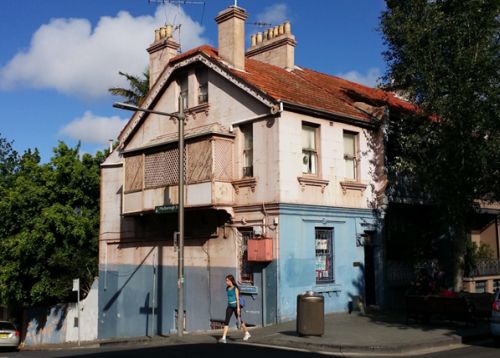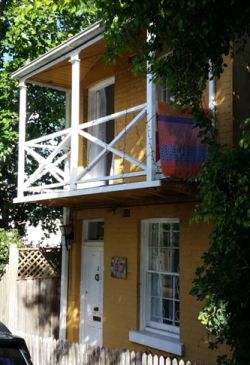‘Belle’ Parr was the victim of a murder-suicide shooting. During the First World War she lived with her husband William, a postal worker, at Ayr House a slate-roofed building he jointly owned at 255 Glebe Point Rd on the corner of Marlborough St (earlier known as Glebe Lane).
The couple separated after quarrelling over Arabella’s accepting business advice from a married man, Alfred Thomas Anderson, rather than her husband. William Parr went to live at Tamworth and Arabella set up a small dairy at Ryde but then announced she would be sharing her house with another dairy farmer, Ebenezer George Hicks, and amalgamating their businesses. On 11 October 1925 Frank Curtis, an 11-year-old milking ‘useful’ who lived on the premises, discovered her body and that of Anderson, his apparent motive being personal and business jealousy. A coronal inquest brought down a verdict of murder and suicide and Arabella was buried in the Church of England section of the Field of Mars cemetery at Ryde. (The Labor Council subsequently took an interest in Frank as an under-age employee, and William Parr remarried.)

Arabella Zarah Keightley (also known as Arabel) was born on 28 March 1888 at Walcha NSW to Maria Isabella Levingston (1867-1955) and stockman/boundary rider/bullock driver John Edward Keightley (1868-1948) who married in 1891 before Keightley, already in trouble with the law for drunkenness, started a prison sentence for horse stealing. During his time in jail the first of their other eight children was born. In 1895 he was discharged on suspicion of arson. A big tall man who claimed he could lift a horse by its hind legs, John Keightley in later life was nicknamed ‘The Crane’ as a hefty labourer for Australian Iron and Steel. His in-laws, the Levingstons, were Walcha pioneers.

At Canterbury in 1910 Arabella married William Coleman Parr (1891-1961). His father William, a clerk, had died aged 45 on 14 July 1907, and his mother Evelyn Amelia (youngest daughter of prosperous Glebe ironmonger Philip Coleman Williams whose story was told in the March 2010 Bulletin) had died aged 43 on 7 December 1908. Executor of Evelyn’s will was her brother-in-law Morden Alfred Pennington (who inherited the Parrs’ land at Ryde). Probate was granted in 1909 and Evelyn’s piano and walnut and cedar furniture disposed of. The orphaned William Coleman Parr and his sisters Adeline Agatha Calladine and Anne Fillingham Boyce inherited Ayr House and 2 Marlborough St on the same title (measuring 7½ perches). In 1926 the real estate passed to their aunt Rose Millicent Williams who sold up the next year.
Advertised as investment properties, with office space and handy to the tram, they were bought by builder Leslie Harold Brigg who ran 255 Glebe Point Rd as a boarding house, and rented 2 Marlborough St to tenants including labourer Albert Victor Carlaw and George Pawley.
In 1956 Brigg subdivided and sold the buildings on separate titles. Subsequent owners of the big house included crane driver Albert Douglas and schoolteacher Valerie Nada Gordon. From 1982-91 medical consulting rooms operated there. The Marlborough St house was owned by the family of stereotyper Rupert James Souter from 1956-74.
Ayr House (six rooms plus bath, kitchen and basement) was built c. 1876 probably by William James Jones a painter and glazier who moved there from Norton St with his younger brother bricklayer Richard, widowed mother Mary Ann and Catherine Jones, a dressmaker. William James Jones snr was a carpenter and joiner who had died aged 47 on 11 March 1860 when the family home was in Greek St. Three years before his own death he had witnessed the death of a fellow worker who stepped backwards off a plank at the top of a new city building 30 ft above the ground.
Circa 1882 the Jones family moved into Marlborough House 2 Marlborough St (iron-roofed, four rooms plus kitchen) and rented out Ayr House whose tenants included Peter Richard Royall (a carpenter who had been declared bankrupt in 1858) and Ernest Charles Davies (a mining broker who had been declared bankrupt as a sugar planter in 1873 and as a storekeeper in 1882. Davies later successfully sued for libel a man who questioned his business credentials).
In 1887 Michael Levy and Rosetta née Phillips moved into Ayr House where their baby grandson Oswald Gervin Elliott Levy died in October 1888. London-born businessman Michael Levy had migrated in 1857 to Sydney with his brother Harry, and set up as a commercial traveller with a four-horse wagonette working its way up Parramatta Rd. By the time of the 1901 census Evelyn and William Parr were living in Ayr House and the Levys had moved to 2 Mansfield St.
In the 1880s and ’90s, probably because of the amount of building rubble lying around, Marlborough St seems to have been a favourite place for young locals to gather and muck about.
Lennox Nesbitt, a teenage plumber of Darling St, was fined for throwing stones and members of the extended Dummett family, of Darling and Talford Sts and Glebe Rd, were charged with riotous behaviour. Marlborough St was the scene of a major fracas on New Year’s Eve 1894 when a crowd of 300 lit their customary bonfire on a vacant block. On the excuse that there was an economic depression but probably for some other reason, lighting such fires had been declared illegal. The two Glebe constables who intervened were beaten up and pelted with blue metal and stones, requiring hospital treatment. Lennox Nesbitt was among those arrested, but an appeal judge said bonfires were an innocent amusement in contrast to ‘the fashionable pastime of pulling down signboards and taking doors off their hinges’ and that the police should not have interfered.









There are no comments yet. Please leave yours.